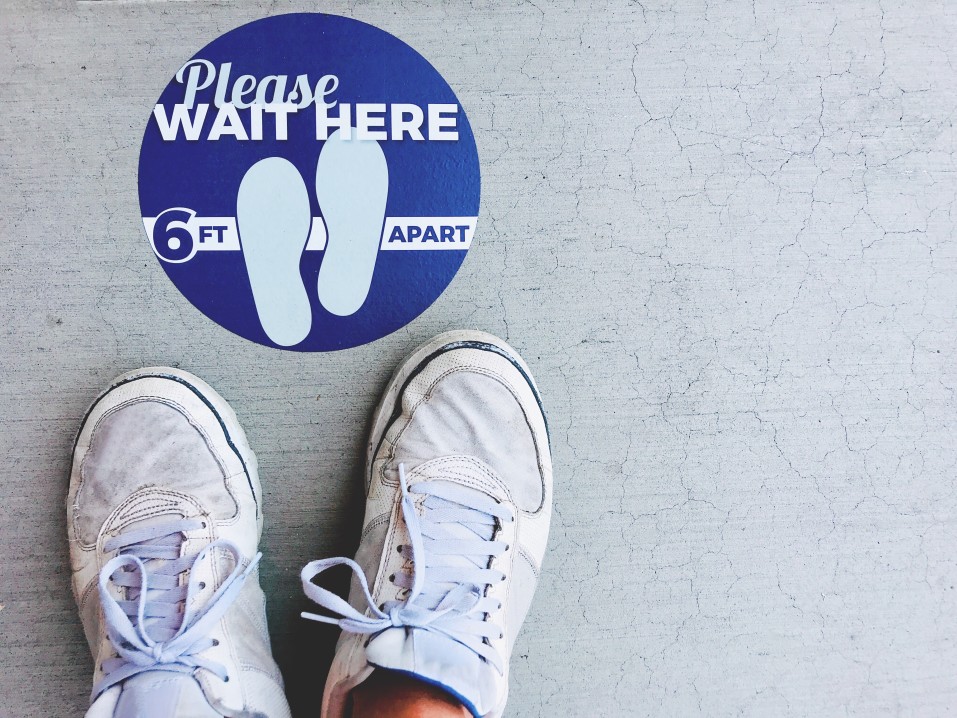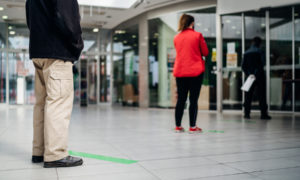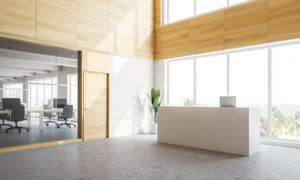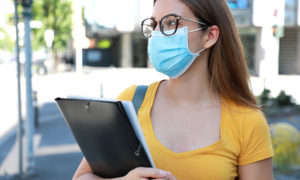As employees start returning to the workplace, they’ll probably notice some changes to their office spaces and business procedures — specifically when it comes to keeping a safe distance from their clients and coworkers.
Below are a few ways office buildings can adapt to encourage social distancing and prevent the spread of pathogens.
Spaced seating and more barriers
To follow the six-foot guidelines, businesses may have to go above and beyond separating desks and workspaces.
Reception areas, lobbies, open offices, and other high traffic areas may require limited entry policies, physical barriers, and spaced seating. But there’s no need to tarnish the visual appeal of these spaces in the process. Clear barriers limit pathogen travel without limiting visibility. And they’re easy to wipe down with disinfectant.
There may also be a need to limit the number of people in smaller shared areas like breakrooms and conference rooms. Alternatively, companies can add smaller break spaces and meeting spots throughout the office.
Elevator policies
For many businesses, the most challenging place to enforce social distancing is in and around the building elevator. The small, enclosed space makes it difficult for employees to stay six feet apart and avoid spreading germs. Not to mention, they have to press a lot of buttons to reach the destination — although some companies are working on a solution for that.
Until more permanent solutions develop, businesses can implement a few changes to help employees maintain their distance and safeguard their health:
- Encourage employees to use stairs when possible
- Limit the occupancy per car
- Add spaced floor markings inside the elevator
- Ask employees to avoid touching buttons, railings, and walls with their hands
- Place hand-sanitizing stations near the elevators
Touchless security
Whenever employees can avoid touching keypads and door handles, they help minimize the spread of disease and make it easier to practice social distancing.
In the spirit of health and safety, businesses can adopt contactless means of access and entry. Doors that unlock via Bluetooth, keycards, or other touchless methods eliminate the need for keypads and manual locks.
Better yet, if the doors open and close automatically, employees won’t even need to touch the door handles. And they can remotely let in clients, delivery personnel, and other guests — no need to come out to meet them.
Telecommuting technology
In the past few months, many companies have shifted to remote work, and that shift may well continue for a while. Four out of five employees say they’d like to work outside of the office at least one day a week, even after the pandemic situation subsides.
To better support and accommodate these remote employees, businesses may have to consider some technology upgrades:
- Reliable audiovisual equipment, internet speed, and phone service to enhance meetings and video conferences
- Software solutions for project management, administrative tasks, file sharing, and team communication
- A network security solution that covers all computers and mobile devices inside and outside the office
The goal is to provide staff with easy-to-use tools, helping them stay seamlessly and securely connected with their clients and with each other, whether they’re at or away from the office.
Smart lockers
Smart package lockers are excellent for facilitating contactless package delivery at the office. But that’s not the only way they support social distancing.
Businesses can use smart lockers to securely transfer all sorts of items — from keycards and parking passes to private documents, eliminating the need for in-person transactions.
Smart lockers also assist with IT asset management by securely storing and transferring laptops, cellphones, and IT equipment. These assets often contain important company data, which is why delivering them in person is preferable. But with smart lockers, the items are only accessible by designated recipients, so they won’t fall into the wrong hands.
Employees could also use the lockers to borrow and return devices. Administrators will then have a record of who has what equipment and when/if they returned it.
Want to use smart package lockers to encourage social distancing in the office? Contact us to get started.




